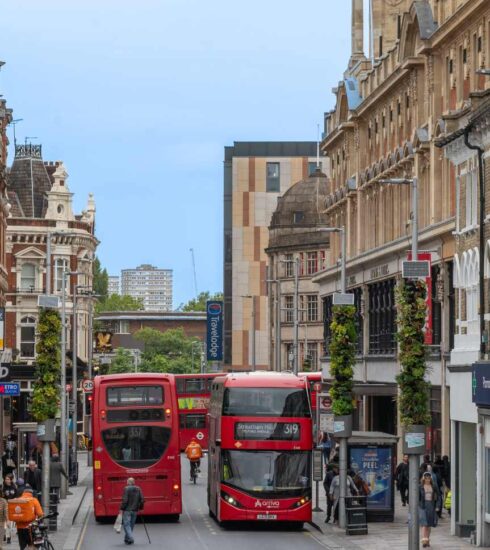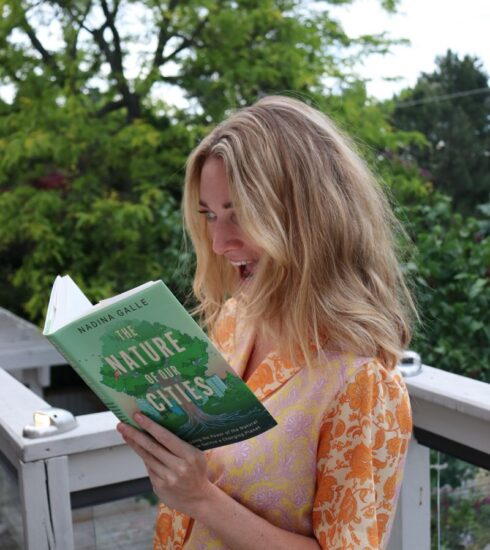From Concept to Community: How Urban Design Impacts Everyday Lives
- Jackie De Burca
- November 18, 2024
Urban design profoundly shapes our daily experiences, influencing how we interact with our environment and one another. Everyday Urbanism, a transformative approach, celebrates the small, ordinary moments that define city life. It recognises that the bustling markets, lively street corners, and daily routines give a city its soul, emphasising sustainability, cultural expression, and community participation1. Jane Jacobs, in her seminal work “The Death and Life of Great American Cities,” argued that a city’s strength lies in its streets and sidewalks where daily life unfolds, challenging traditional top-down planning approaches.
This people-centred approach to urban design creates inclusive, resilient cities full of life1. Small, strategic changes based on the principles of Everyday Urbanism can make public spaces more inviting and usable for daily activities, while1 involving local communities in the design and planning processes leads to more sustainable and resilient urban environments.
Key Takeaways
- Urban design profoundly shapes everyday life, influencing how we interact with our environment and each other.
- Everyday Urbanism celebrates the small, ordinary moments that define city life, emphasising sustainability, cultural expression, and community participation.
- Jane Jacobs challenged top-down planning approaches, arguing that a city’s strength lies in its streets and sidewalks where daily life unfolds.
- Small, strategic changes based on Everyday Urbanism can make public spaces more inviting and usable for daily activities.
- Involving local communities in urban design and planning processes leads to more sustainable and resilient urban environments.
Understanding Urban Design and Its Importance
Urban design is the art of creating places for people, focusing on the physical features of cities and towns and how they impact human experiences. It is a crucial aspect of urban planning that shapes the built environment to enhance the quality of life for residents.2 By prioritising human-scale design, walkability, and community interaction, urban designers strive to create liveable, sustainable urban environments2.
Definition of Urban Design
Urban design encompasses the arrangement, appearance, and functionality of the physical elements that make up a city or town. It involves the design of streets, buildings, public spaces, and infrastructure to create a cohesive, visually appealing, and user-friendly urban landscape3. Urban design is a multidisciplinary field that incorporates principles from architecture, landscape architecture, transportation planning, and social sciences to address the complex needs of urban communities3.
Key Principles of Urban Design
- Human-scale design: Ensuring that the built environment is designed at a scale that is comfortable and accessible for pedestrians, promoting a sense of human connection and community.
- Prioritising pedestrians: Designing streets, sidewalks, and public spaces that prioritise the needs of pedestrians, cyclists, and public transportation users over private vehicles.
- Creating comfortable, accessible spaces: Incorporating elements such as shaded areas, seating, and inclusive design features to make urban spaces inviting and accessible for people of all ages and abilities.
- Integrating green spaces: Incorporating natural elements like parks, gardens, and trees into the urban fabric to provide environmental, social, and health benefits for residents.
- Fostering community interaction: Designing public spaces that encourage social gathering, interaction, and a sense of belonging among community members.
These key principles of urban design aim to create vibrant, liveable cities that prioritise the needs and well-being of the people who inhabit them23. By applying these principles, urban designers can positively impact the physical, mental, and social health of urban residents23.
“The quality of the physical environment has a huge impact on the quality of life. Urban design is about creating places for people.” – Jan Gehl, Danish architect and urban design consultant
The Role of Urban Design in Community Development
Urban design has evolved significantly over time, shifting from a focus on monumental projects to a more participatory, community-driven approach4. Historically, urban planning often overlooked the needs and experiences of local residents, prioritising grand schemes over the everyday realities of the people who inhabit the city4. However, modern applications of urban design emphasise the importance of engaging with the community and ensuring that development projects are grounded in the lived experiences of the people they aim to serve4.
Historical Context
In the past, urban design commonly concentrated on monumental projects, such as large-scale infrastructure and architectural landmarks, often at the expense of community needs4. This approach frequently resulted in the displacement of local residents and the disruption of established social networks and cultural practices5. The redevelopment in the Cheonggyecheon-Euljiro area of Seoul, for example, led to the displacement of historical workshops, impacting the cultural values and social connections of the local community5.
Modern Applications
In contrast, modern urban design emphasises a more collaborative and inclusive approach, where residents’ experiences guide the development process5. This shift has been driven by a recognition that cities are not merely physical structures, but living, breathing entities shaped by the people who inhabit them5. By engaging with local communities and incorporating their perspectives, urban planners can create spaces that are adaptable, inclusive, and grounded in the everyday realities of the people who use them5.
A prime example of this community-focused approach is the transformation of New York City’s Times Square from a congested traffic hub into a pedestrian-friendly gathering space5. This project, which involved input from residents and stakeholders, has created a vibrant public space that caters to the needs of the local community and attracts visitors from around the world5.
Informal urbanism, such as street vendors and community gardens, also plays a vital role in the urban ecosystem, providing essential services and economic opportunities for local residents5. These grassroots initiatives demonstrate the importance of recognising and supporting the diverse ways in which people interact with and shape their built environment5.
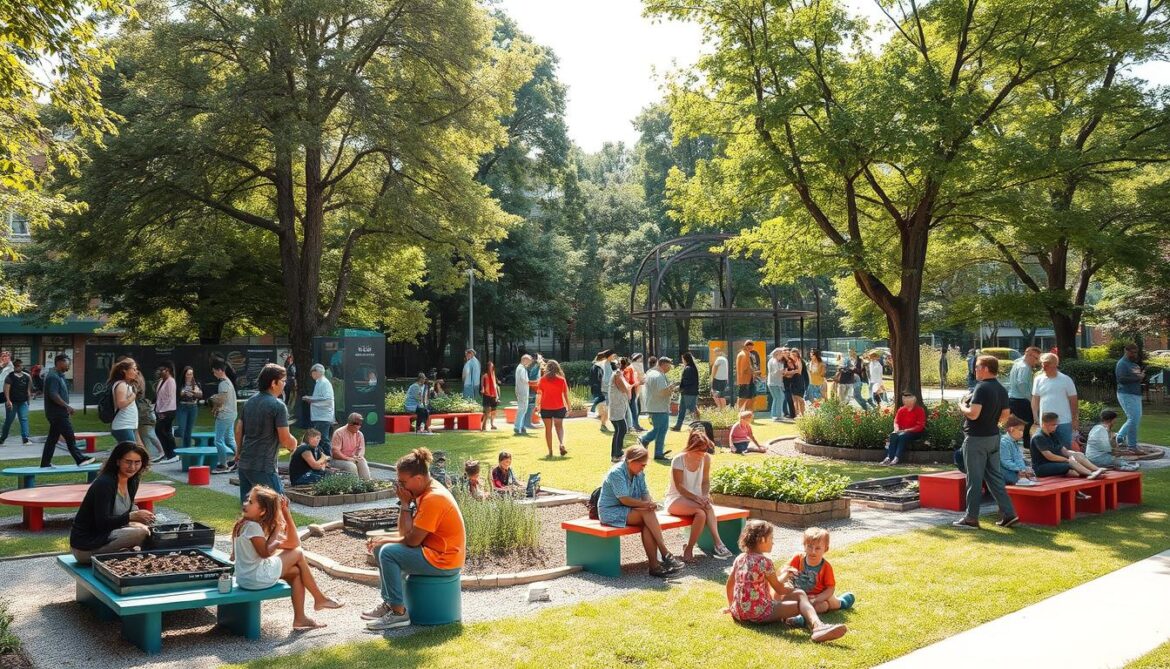
Overall, the role of urban design in community development is crucial, as it shapes the spaces where people live, work, and interact4. By prioritising the needs and experiences of local residents, urban planners can create cities that are more inclusive, resilient, and adaptable, ultimately improving the quality of life for all who call them home4.
How Urban Design Affects Transportation
Urban design plays a crucial role in shaping transportation patterns and choices within a community. Well-designed public transport systems, walkable neighbourhoods, and cycling infrastructure can significantly reduce car dependency, lower carbon emissions, and improve air quality6. Copenhagen’s extensive cycling network is a prime example of how urban design can promote sustainable transportation7.
Public Transport Systems
Integrating public transit infrastructure into the overall urban design is essential for encouraging the use of buses, trains, and other modes of public transportation7. By prioritizing the convenience and accessibility of public transport, urban planners can reduce reliance on private vehicles, decrease traffic congestion, and enhance air quality7.
Walkability and Cycling Infrastructure
Designing for walkability and cycling is a cornerstone of sustainable urban development7. Active transport opportunities should be embedded in people’s daily routines, with safe walkability and bikeability prioritised through protected lanes, bicycle parking, and convenient connections between different parts of the city7. This not only promotes physical activity and overall well-being, but also contributes to a reduction in air pollution levels by decreasing vehicle emissions7.
Furthermore, the integration of micro-mobility solutions, such as e-scooters and bike-sharing programs, can provide last-mile connectivity and extend the reach of public transportation systems, offering residents and visitors more transportation choices7.
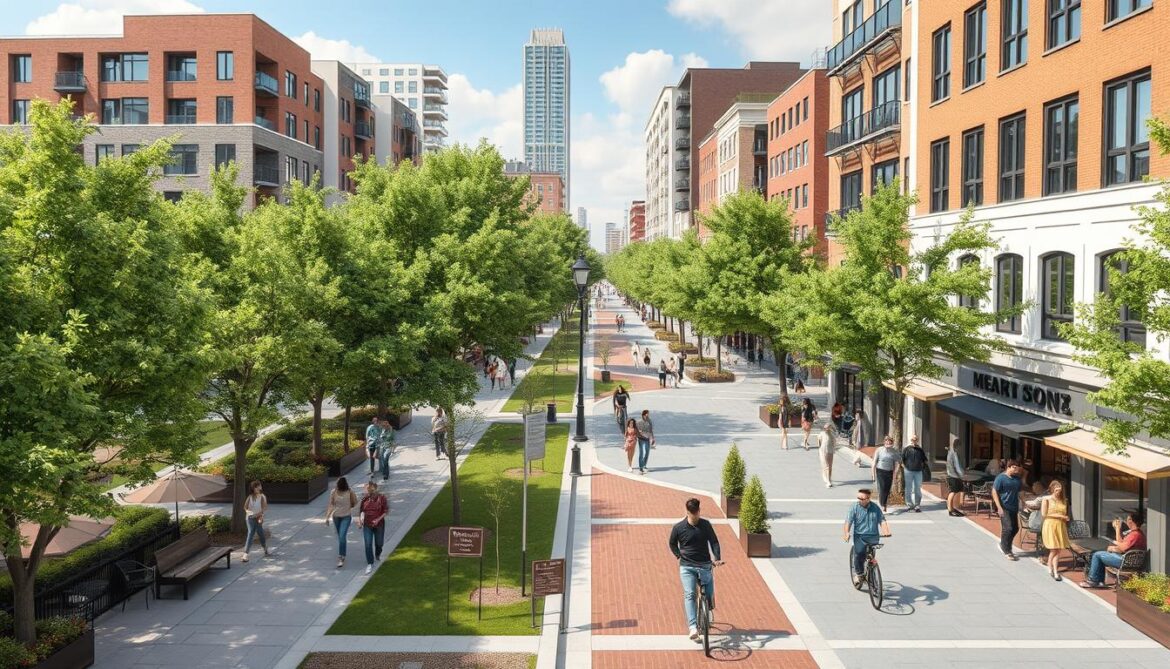
“Walkable cities are not just more environmentally sustainable, they’re more economically productive, they’re healthier, and they’re more equitable.” – Jeff Speck, urban planner and author
The Influence of Green Spaces
Green spaces play a vital role in enhancing the wellbeing of urban communities8. Studies have shown that access to natural settings in neighbourhoods improves and maintains mental health, reduces depression and stress, and enhances social and cognitive functioning8. Urban design should integrate green spaces into all plans, ensuring consistent, regular exposure to nature in daily routines. This includes street trees, flowers, views of nature from office windows, and gardens for lunch breaks.
Benefits of Parks and Gardens
Green spaces provide a multitude of benefits for urban residents8. One experiment demonstrated that individuals who took their break in a green space showed increased focus and higher concentration levels compared to those who took their break near a busy street intersection8. Additionally, green spaces have been associated with a lower risk of depression, faster psychological stress recovery, and increased focus and attention8. Exposure to green spaces also lowers cortisol levels, reduces anxiety, improves mood, and enhances overall mental well-being8.
Furthermore, green urban landscapes contribute to combatting sedentary lifestyles, obesity, and related health issues by encouraging outdoor activities and exercise8. Greenery in urban areas also helps filter pollutants from the air, reducing the risk of respiratory diseases and allergies, and mitigates the urban heat island effect, decreasing heat-related illnesses during hot weather8.
Urban Agriculture Initiatives
Urban agriculture initiatives can provide additional benefits to green spaces in cities. These projects not only offer fresh produce but also create community bonds and contribute to sustainability efforts9. Studies show a consistent positive association between urban green space exposure and attention, mood, and physical activity9. Green spaces in urban environments also foster social interaction, community building, and emotional well-being among residents8.
| Benefit | Description |
|---|---|
| Mental Health | Green spaces improve mental health, reduce depression and stress, and enhance cognitive functioning8. |
| Physical Health | Green spaces encourage outdoor activities, exercise, and reduce the risk of respiratory diseases and obesity8. |
| Community Building | Green spaces foster social interaction, community bonds, and emotional well-being among urban residents8. |
| Sustainability | Urban agriculture initiatives in green spaces provide fresh produce and contribute to sustainability efforts9. |
In summary, the integration of green spaces into urban planning is crucial for promoting the overall well-being of city dwellers. From enhancing mental health to encouraging physical activity and fostering community connections, green spaces play a vital role in creating sustainable and livable urban environments89.
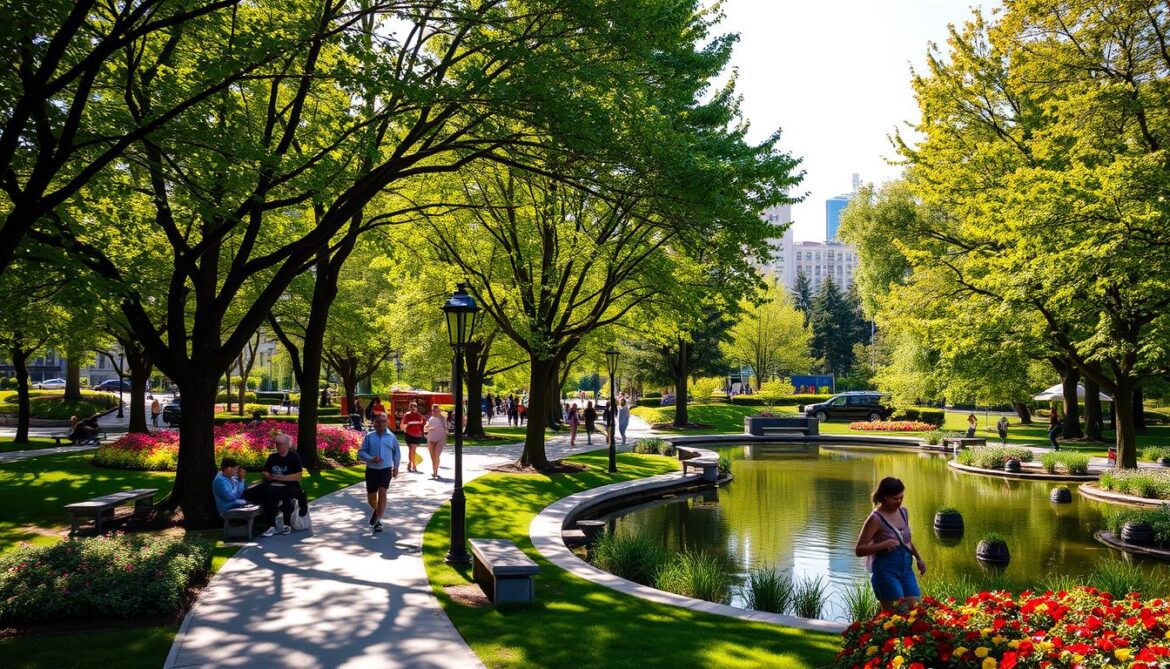
Creating Inclusive Environments
Inclusive urban design is a critical aspect of building accessible and welcoming cities for all10. Inclusive urban design aims to create spaces that are accessible and welcoming to everybody, regardless of age, ability, or background11. Inclusive city planning aims to provide equal access to economic, cultural, and political opportunities for all, regardless of economic status, gender, ethnicity, disability, age, sexual identity, nationality, or religion.
Designing for Accessibility
Designing for accessibility involves implementing principles of universal design to ensure that urban environments cater to diverse needs12. Inclusive design aims to remove barriers to create undue effort and separation12. Inclusive design places people at the heart of the design process, acknowledging diversity and difference, and offering flexibility in use10. Universal Design Principles form the foundation of inclusive urban design, including equitable use, flexibility, simple design, perceptible information, tolerance for error, low physical effort, and space for approach and use.
Engaging Diverse Communities
12 Inclusive design is about making places everyone can use, and good design should always be judged by whether it achieves an inclusive environment10. Inclusive urban design techniques include creating barrier-free spaces, clear signage, safe public spaces, and accommodating diverse cultural and social practices10. Inclusive architecture techniques involve designing entrances with ramps, color and texture differentiation for visually impaired navigation, optimal lighting, and flexible seating.
10 Inclusive urban design promotes social equity by ensuring equitable distribution of resources, community engagement, and prioritizing affordable housing options11. The concept of a “15-minute city” is adopted in Paris, creating districts where residents have all essentials within a short distance11. In Barcelona, urban planning is focused on making living spaces inclusive by providing necessary amenities within neighbourhoods and ensuring safe and accessible public spaces.

“Inclusive design places people at the heart of the design process, acknowledging diversity and difference, and offering flexibility in use.”12
| Inclusive Urban Design Examples | Key Features |
|---|---|
| The High Line, New York City | 10Transformed a former railway into an accessible park supporting community interaction. |
| Barangaroo Reserve, Sydney | 10Incorporates ramps and tactile guides for inclusion. |
| University of California, Berkeley Campus | 10Includes accessible paths and signage for universal access. |
By embracing the principles of inclusive urban design, cities can create environments that are accessible, engaging, and welcoming to all10. The ‘shared space’ concept in urban planning, where pedestrian, bicycle, and motor vehicle traffic share the same space, benefits everyone by reducing traffic speed and increasing safety.
The Impact of Urban Design on Public Health
Urban design significantly influences public health by promoting active lifestyles and supporting mental well-being13. More than 55% of the world’s population currently live in urban areas, a figure expected to increase to 68% over the next 20-30 years13. This urbanization trend brings challenges to urban well-being, including sedentary lifestyles, noncommunicable diseases, loneliness, and social segregation13.
Promoting Active Lifestyles
Regular exercise, facilitated by well-designed urban spaces, is as effective as anti-depressants for treating mild-moderate depression and improves self-esteem, anxiety, and stress13. Urban design can encourage physical activity through active transport options, integrating exercise opportunities into urban places, and providing dedicated spaces for sports and recreation.
Mental Health and Well-being
Green spaces and opportunities for social interaction are crucial for mental health, reducing stress and promoting community cohesion13. Tools have been developed to measure the effect of initiatives on urban behaviour and health, based on international collaborations and funded by the philanthropic association Realdania13. A new holistic planning method and tools have been developed to integrate health and planning, including aspects like health equity, quality of life, social neighbourhoods, green areas, active living, and research integration13. The method and tools provide a comprehensive approach to promoting health, well-being, and quality of life in urban environments, applicable across various scales and phases of development13.
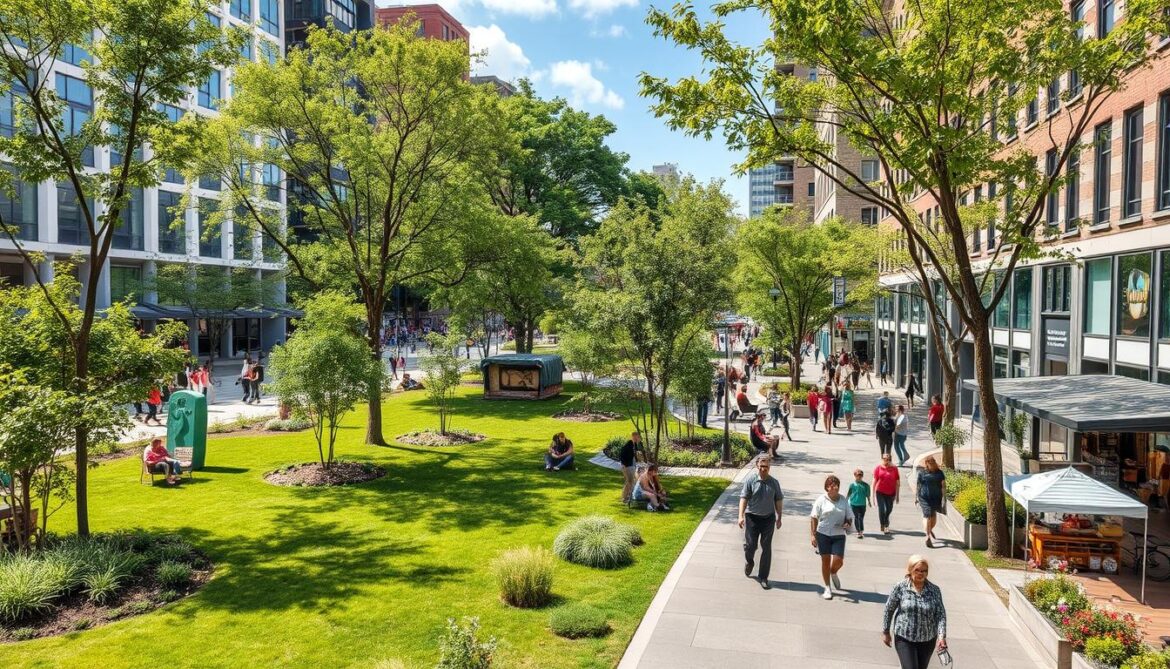
“The project ‘The Future’s Urban Health Culture’ focuses on introducing health and well-being demands in planning documents, fostering collaborations across sectors, and developing a holistic approach to health encompassing social, mental, and physical well-being.”13
Effective urban design can have a significant impact on public health, promoting active lifestyles and supporting mental well-being. By integrating comprehensive health considerations into urban planning, cities can create environments that enhance the overall quality of life for their residents.
Enhancing Economic Opportunities
Well-designed urban spaces can have a significant impact on local economies. Public spaces, such as bustling markets, quiet parks, and lively street corners, are vital to urban life as they provide opportunities for people to gather, interact, and build community14. The transformation of these public spaces, like the redesign of New York City’s Times Square into a pedestrian-friendly area, can reshape the dynamics of a city14.
Informal urban practices, such as street vending and community gardens, contribute to the urban ecosystem by providing essential services and creating economic opportunities14. Human-scale design, which prioritises pedestrians over cars, is exemplified in cities like Copenhagen, known for its bike-friendly infrastructure and walkable streets14. Community participation in urban planning processes leads to more sustainable and resilient urban environments14.
Supporting Local Businesses
Everyday Urbanism, which focuses on the everyday practices and experiences of urban residents, can have economic benefits by supporting local businesses, encouraging entrepreneurship, and attracting investment14. Promoting cultural expression in cities fosters social ties and creates a richer, more inclusive urban environment14.
Attracting Investment
Sustainable urban planning through Everyday Urbanism prioritises practices like walking, cycling, and public transport to promote healthier, happier, and more sustainable communities14. This approach can attract investment and create dynamic urban environments, as seen in the economic vibrancy of local businesses and the increased appeal of urban areas for residents and visitors alike14.
“Well-designed public spaces offer benefits such as improved physical and mental health, increased sense of wellbeing and happiness, support for cognitive development in children, and decreased car use.”15
By supporting local businesses, encouraging entrepreneurship, and attracting investment, urban design can play a crucial role in enhancing the economic opportunities within a community14. This, in turn, can contribute to the overall economic vibrancy and social inclusiveness of the urban environment14.
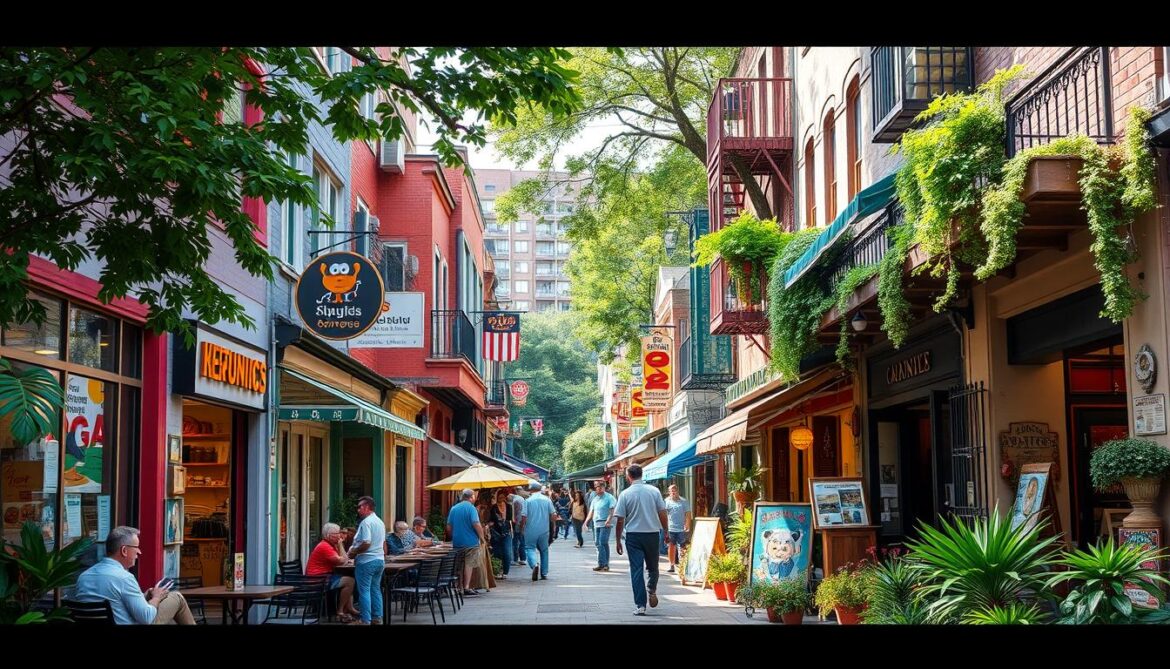
The Relationship Between Urban Design and Sustainability
Sustainable urban design plays a pivotal role in creating cities that are environmentally responsible and economically resilient. By incorporating eco-friendly materials and practices, urban planners can significantly reduce the environmental impact of development projects16. Strategies like promoting walkable neighbourhoods, supporting public transport, and enhancing green spaces not only improve the quality of urban life but also contribute to building more sustainable cities.
Eco-friendly Materials and Practices
Green building techniques, renewable energy systems, and water conservation measures are essential components of sustainable urban design16. These eco-friendly practices not only reduce resource consumption but also promote energy efficiency, helping to mitigate the effects of climate change. By utilising sustainable materials and adopting innovative construction methods, urban designers can create built environments that are both aesthetically pleasing and environmentally responsible.
Mitigating Urban Heat Islands
One of the key challenges in sustainable urban design is the mitigation of urban heat islands, which occur when built-up areas experience significantly higher temperatures compared to surrounding rural or suburban areas16. Strategic placement of green spaces, reflective surfaces, and proper building orientation can help improve urban microclimates and reduce energy consumption required for cooling buildings.
Sustainable urban design also promotes walkable neighbourhoods and efficient public transportation systems, reducing reliance on cars and lowering carbon emissions16. This not only enhances the environmental sustainability of cities but also fosters a sense of community and improves the overall quality of life for urban residents.
“Everyday Urbanism emphasizes small-scale, user-driven urban design approaches that prioritize human interaction and community needs over traditional top-down planning methods.”16
By embracing sustainable design principles, urban planners can create cities that are not only environmentally responsible but also socially inclusive and economically vibrant16. This holistic approach to urban development is crucial in addressing the pressing challenges of our time and ensuring the long-term sustainability of our communities.
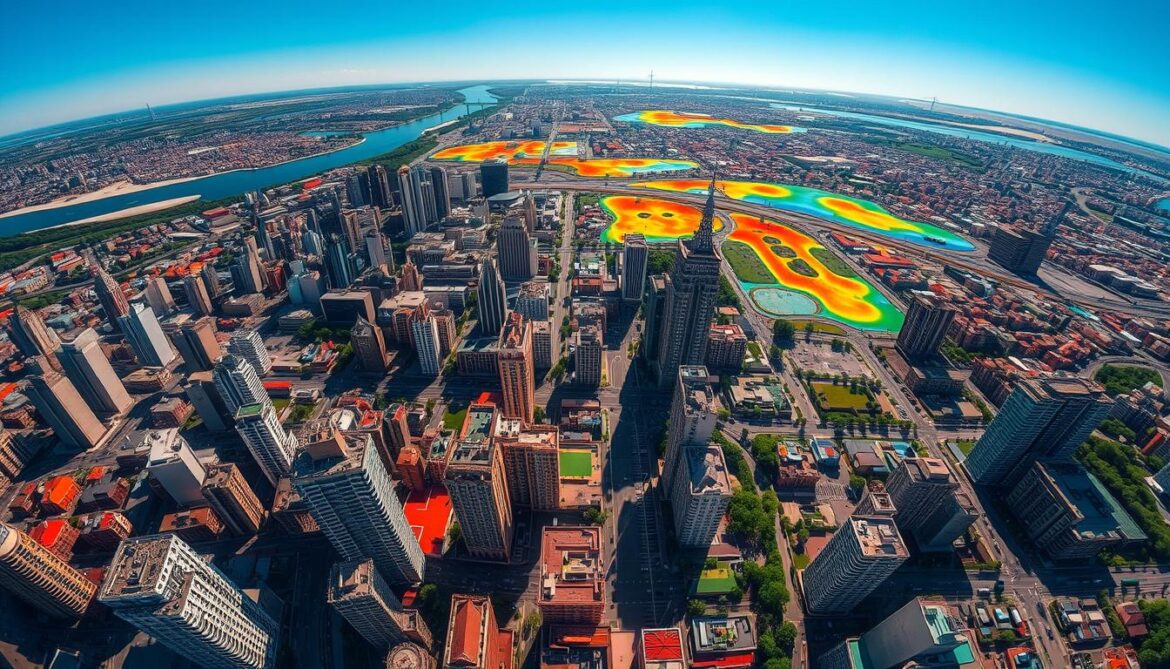
Sustainable urban design is a critical component of creating livable, resilient, and environmentally-conscious cities17. By prioritising eco-friendly materials, mitigating urban heat islands, and promoting sustainable transportation, urban planners can contribute to the long-term well-being of both people and the planet16. This integrated approach to urban design is essential for building a more sustainable future.
Future Trends in Urban Design
As the world becomes increasingly urbanised, the future of urban design is poised to be shaped by a confluence of technological advancements and a focus on resilience18. The integration of smart city technologies, driven by the Internet of Things (IoT), data analytics, and artificial intelligence (AI), is set to revolutionise the way cities function and respond to the needs of their residents19.
AI is already being seamlessly integrated into urban design and planning processes, assisting in creating responsive urban environments driven by real-time data19. Urban designers are leveraging AI to design more efficient and sustainable urban spaces, optimising for factors like energy consumption and waste management19. Furthermore, AI is playing a crucial role in enhancing urban mobility, with predictive analytics improving public transportation planning and real-time traffic management19.
Alongside the embrace of smart city technologies, the concept of adaptive reuse and urban resilience is gaining traction18. As cities strive to accommodate18 an influx of nearly 2.5 billion new inhabitants in the future, the preservation and repurposing of existing structures has become paramount. This approach not only preserves a city’s heritage but also meets the evolving needs of its residents, while contributing to more sustainable and climate-resilient urban development20.
FAQ
What is the definition of urban design?
What are the key principles of urban design?
How has the approach to urban design evolved over time?
How does urban design affect transportation choices?
What are the benefits of incorporating green spaces in urban design?
How can urban design create inclusive environments?
How does urban design impact public health?
What are the economic benefits of well-designed urban spaces?
How can urban design contribute to sustainability?
What are some future trends in urban design?
Source Links
- Everyday Urbanism: Transforming Daily Life In Cities – https://urbandesignlab.in/everyday-urbanism/?srsltid=AfmBOorwugkAb4c0PLTZgZziUQRdHT4_y9W6WK-bFJTwWZ0Kvyn4rakx
- How Urban Design Can Impact Mental Health & Well-being | NeuroLandscape – https://neurolandscape.org/2024/09/09/how-urban-design-can-impact-mental-health-well-being/
- Living space and health: Does urban design affect our health? – https://www.medicalnewstoday.com/articles/living-space-and-health-how-urban-design-affects-our-well-being
- The Importance of Urban Planning – The Seven Key Reasons – Archistar – https://www.archistar.ai/blog/the-importance-of-urban-planning-the-seven-key-reasons/
- Cities: how urban design can make people less likely to use public spaces – https://theconversation.com/cities-how-urban-design-can-make-people-less-likely-to-use-public-spaces-184079
- Urban Planning and How it Affects Your Daily Life – https://www.greenoglobal.com/articles/the-complete-guide-to-urban-planning-and-how-it-affects-your-daily-life
- Transportation-Focused Urban Design Trends – https://www.snyder-associates.com/transportation-focused-urban-design-trends-shaping-sustainable-and-connected-cities/
- Transforming Urban Landscapes: The Impact of Green Spaces on Mental and Physical Health, NYC – https://www.integrative-psych.org/resources/transforming-urban-landscapes-the-impact-of-green-spaces-on-mental-and-physical-health-2
- Urban Green Space and Its Impact on Human Health – https://pmc.ncbi.nlm.nih.gov/articles/PMC5876990/
- Inclusive Urban Design: Techniques & Examples – https://www.vaia.com/en-us/explanations/architecture/land-and-property-management/inclusive-urban-design/
- From cities that discriminate to cities for everyone: inclusive urban planning – https://www.activesustainability.com/construction-and-urban-development/urban-planning-inclusive/
- The principles of inclusive design: they include you – https://www.designcouncil.org.uk/fileadmin/uploads/dc/Documents/the-principles-of-inclusive-design.pdf
- The Urban Health Culture of the Future – https://www.landscapefirst.com/the-urban-health-culture-of-the-future/
- Everyday Urbanism: Transforming Daily Life In Cities – https://urbandesignlab.in/everyday-urbanism/?srsltid=AfmBOorrQs8ShJkU_iTiD_tu2cGoQnQkufFDACPv4cJhGlumLsI0nWMt
- The case for good design: Urban design – https://www.ovga.vic.gov.au/case-good-design-urban-design-guide-government
- Everyday Urbanism: Transforming Daily Life In Cities – https://urbandesignlab.in/everyday-urbanism/?srsltid=AfmBOorTqQJBOjQnxiAuhkoAsv0f6mmfwQUIQiR2lMH9INZipM7I2uWY
- Social sustainability: putting the heart into urban planning | Eve Reed – https://www.teaandwater.co/insights/cities/human-urban-planning/
- PDF – https://unhabitat.org/sites/default/files/2022/07/chapter_6_wcr_2022.pdf
- Artificial Intelligence and Urban Design – https://www.aiplusinfo.com/blog/artificial-intelligence-and-urban-design/
- Overview – https://www.worldbank.org/en/topic/urbandevelopment/overview







